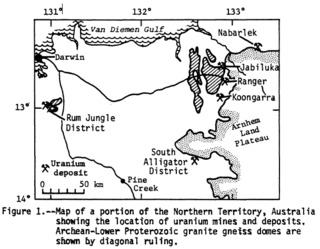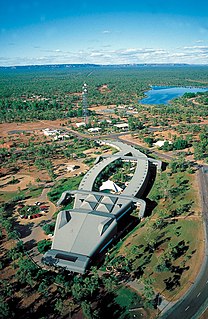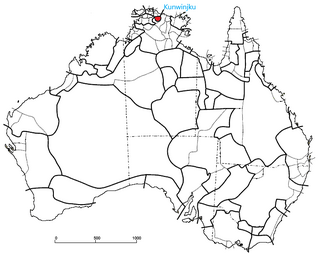
Kakadu National Park is a protected area in the Northern Territory of Australia, 171 km (106 mi) southeast of Darwin. It is a World Heritage Site. Kakadu is also gazetted as a locality, covering the same area as the national park, with 313 people recorded living there in the 2016 Australian census.
The Jawoyn, also written Djauan, are an Australian Aboriginal people living in the Northern Territory of Australia. The Bagala clan are of the Jawoyn people.

Alligator Rivers is the name of an area in an Arnhem Land region of the Northern Territory of Australia, containing three rivers, the East, West, and South Alligator Rivers. It is regarded as one of the richest biological regions in Australia, with part of the region in the Kakadu National Park. It is an Important Bird Area (IBA), lying to the east of the Adelaide and Mary River Floodplains IBA. It also contains mineral deposits, especially uranium, and the Ranger Uranium Mine is located there. The area is also rich in Australian Aboriginal art, with 1500 sites. The Kakadu National Park is one of the few World Heritage sites on the list because of both its natural and human heritage values. They were explored by Lieutenant Phillip Parker King in 1820, who named them in the mistaken belief that the crocodiles in the estuaries were alligators.

Jabiru is a town in the Northern Territory of Australia. Built in 1982, the town is completely surrounded by Kakadu National Park. At the 2016 census, Jabiru had a population of 1,081. It is named after the black-necked stork often seen in the wetlands and billabongs of Kakadu, which is commonly referred to in Australia as a Jabiru.
Big Bill Neidjie, nicknamed "Kakadu Man", was the last surviving speaker of the Gaagudju language, an Aboriginal Australian language from northern Kakadu, after which Kakadu National Park is named. He was an elder of the Gaagudju people and a custodian of the land, who cared deeply about preserving his culture and land.

Gunbalanya is an Aboriginal Australian town in west Arnhem Land in the Northern Territory of Australia, about 300 kilometres (190 mi) east of Darwin. The main language spoken in the community is Kunwinjku. At the 2021 Australian census, Gunbalanya had a population of 1,177.
Ngomburr, also spelt Ngumbur, is a supposed extinct Australian Aboriginal language. It has sometimes been assumed to be a dialect of Umbugarla, but it is not attested; the only evidence to go on is that neighbouring peoples reported that it was similar to Umbugarla. It was spoken to the west of the South Alligator River, between the Ga'baarlgu and the South Alligator River, in Kakadu, Northern Territory.

Gaagudju is an extinct Australian Aboriginal language formerly spoken in the environs of Kakadu National Park, in Arnhem Land, Northern Territory, Australia.

Giimbiyu is an extinct Aboriginal Australian language isolate once spoken by the Giimbiyu people of northern Australia.
Bininj Kunwok is an Australian Aboriginal language which includes six dialects: Kunwinjku, Kuninjku, Kundjeyhmi, Manyallaluk Mayali (Mayali), Kundedjnjenghmi, and two varieties of Kune. Kunwinjku is the dominant dialect, and also sometimes used to refer to the group. The spellings Bininj Gun-wok and Bininj Kun-Wok have also been used in the past, however Bininj Kunwok is the current standard orthography.
The Amurdak, people, also written Amarak and Ngamarak, are an indigenous Australian people of the Cobourg Peninsula in the Northern Territory.
The Warumungu are a group of Aboriginal Australians of the Northern Territory. Today, Warumungu are mainly concentrated in the region of Tennant Creek and Alice Springs.

The Kunwinjku people are an Australian Aboriginal people, one of several groups within the Bininj people, who live around West Arnhem Land to the east of Darwin, Northern Territory. Kunwinjku people generally refer to themselves as "Bininj" in much the same way that Yolŋu people refer to themselves as "Yolŋu".
Wanggamala, also spelt Wanggamanha, Wangkamahdla, Wangkamadla, Wangkamanha, Wangkamana, Wonkamala, Wongkamala, Wonkamudla, and other variants, is an extinct Australian Aboriginal language of the Pama–Nyungan family, previously spoken in the Northern Territory around Hay River and to the south of the Andegerebinha-speaking area.
The Giimbiyu were an indigenous Australian people of the Northern Territory. Their descendants having adopted the Kunwinjku language.
The Bininj are an Aboriginal Australian people of Western Arnhem land in the Northern Territory. The sub-groups of Bininj are sometimes referred to by the various language dialects spoken in the region, that is, the group of dialects known as Bininj Kunwok; so the people may be named the Kunwinjku, Kuninjku, Kundjeyhmi (Gundjeihmi), Manyallaluk Mayali, Kundedjnjenghmi and Kune groups.
The Ngardok were an indigenous Australian people of the Northern Territory. Nothing is known of the language, which has been extinct since about WW2.
The Ngormburr, also known as Murumburr and other variants, are an Aboriginal Australian people of the Northern Territory.
The Norweilemil were an indigenous Australian people of the Northern Territory.
The Limilngan, also known by the exonym Minitja and Buneidja, are an Aboriginal Australian people of the Northern Territory. Earlier ethnologists such as Norman Tindale referred to the group as Puneitja or variants of that spelling.